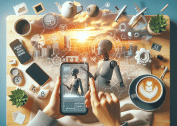Artificial intelligence is transforming the devices, apps, and platforms used every day. Explore how AI tools are shaping everything from smartphone cameras to smart homes and see why understanding these advancements might matter more than you think.
The Rise of AI in Daily Applications
Artificial intelligence has made its way into daily technology so subtly that it often goes unnoticed. From voice assistants on smartphones to recommendation engines in streaming services, AI tools are working behind the scenes to tailor experiences uniquely and efficiently. This integration has become an expected feature of many devices, as users begin to demand more intuitive interactions. More than just a buzzword, machine learning helps predict preferences, automate mundane tasks, and even anticipate user needs through behavioral analysis. Tech giants invest heavily in developing AI-powered features, believing that smarter systems lead to higher satisfaction. For most people, these features are so deeply woven into apps and devices that life without them seems unimaginable.
Consumers may notice AI when unlocking phones with facial recognition or when autocorrect suggests the right words at the right time. What may not be obvious is the complexity of the underlying algorithms. Developers utilize neural networks, deep learning, and natural language processing to deliver seamless, responsive interactions. The ultimate goal is to make technology less intrusive and more supportive. As these systems learn from individual behaviors, they adapt dynamically, further personalizing user experiences. This silent, continual customization helps devices become not just smarter but more attuned to routines and habits.
AI’s influence goes well beyond obvious touchpoints. It impacts logistics in online shopping, customer service chatbots, and even security systems through anomaly detection. Businesses benefit through increased efficiency, reduced manual intervention, and a smoother customer journey. As AI continues to evolve, expect the boundary between human intention and technological action to blur further. This raises creative opportunities but also new questions about privacy, ethics, and digital literacy. Understanding foundational aspects of artificial intelligence helps users better navigate choices about the technology that powers their lives.
Smart Homes: When AI Meets Daily Living
Smart home devices are rapidly shifting the expectations for modern living. Voice-activated assistants such as Alexa and Google Home actively listen, interpret, and respond to commands ranging from checking the weather to adjusting lighting—thanks to embedded AI tools. These systems leverage machine learning to recognize patterns in speech, routine, and environment. Over time, as AI systems collect more data, they can automate processes, anticipate household needs, and improve overall efficiency, creating a sense of convenience that many quickly come to rely on.
Beyond voice assistants, AI enhances thermostats, security cameras, and appliances. Smart thermostats, for example, monitor user preferences and external conditions to optimize temperature, saving both energy and money. AI-powered security systems can distinguish regular household activity from unusual movements, sending alerts only when genuine risks are detected. Such advancements in predictive maintenance mean home equipment can often self-diagnose issues before users are even aware of them, potentially reducing costs and preventing breakdowns.
The sheer scale of integration means AI impacts not just comfort but also sustainability. Devices utilizing AI can minimize waste by learning when to run appliances or when to power down unused systems, contributing to greener living. Interconnected sensors and intelligent platforms foster homes that are increasingly adaptive and responsive. However, as dependency on AI grows, so does the importance of understanding how personal data is gathered, stored, and shared by these devices. Transparency and digital safety have become as essential as convenience itself in the new standard for daily living.
AI in Communication and Entertainment
The entertainment industry has seen transformative changes through artificial intelligence. AI tools now drive music and video recommendations on platforms like Spotify and Netflix, predicting preferences and introducing surprise content with uncanny accuracy. Algorithms process vast amounts of user behavior data to suggest movies, shows, or songs that align closely with taste patterns—turning passive entertainment into a curated experience. The result? Audiences discover more relevant content with less effort, boosting engagement and satisfaction.
Communication apps benefit from AI in subtle yet powerful ways. Email platforms prioritize important messages, filter out spam, and even suggest concise responses. Social media leverages sentiment analysis, image recognition, and automated moderation to keep conversations productive and safe. Some tools offer real-time language translation, enabling seamless communication across borders. The union of AI and communication tech ensures that not only is information accessible, but it’s also organized and tailored in real time to keep people connected and informed more effectively than ever.
As creative industries harness AI for content production—whether that’s generating synthetic voices, summarizing news, or helping compose music—the definition of authorship itself is shifting. AI can help produce draft versions, generate illustrations, or analyze large texts for recurring themes in storytelling. While this raises intriguing possibilities for creators, it also requires thoughtful discussion about originality and intellectual property. Yet, when managed responsibly, AI amplifies human creativity, opening up new channels for expression and connection in entertainment and communication.
Enhancing Health and Wellness through AI
Healthcare is another sector where artificial intelligence makes a profound daily impact. Wearable fitness trackers, powered by sophisticated AI tools, monitor everything from heart rate to sleep quality and provide actionable wellness advice. Personal health apps use machine learning to interpret activity logs, remind users to stay active, and even detect irregular health indicators that warrant medical attention. By leveraging predictive analytics, these solutions empower individuals to take proactive steps toward better health—often before they ever visit a doctor.
Beyond personal wellness, AI plays a vital role in clinics and hospitals. Diagnostic systems analyze vast medical data sets, flagging patterns and anomalies that could indicate rare diseases more quickly than traditional approaches. AI-powered telemedicine platforms streamline consultations by prioritizing cases and assisting doctors with patient histories. These systems mean care is more accessible and wait times can often be reduced. With the rise of remote monitoring and home-based care, AI continues to support both patients and practitioners in closing gaps within healthcare delivery.
Ethical deployment is essential as the lines between technology and health advice grow increasingly blurred. AI can only be as effective as the data it’s trained on, and biases in datasets may impact recommendations or diagnostics. Ensuring diverse representation and transparency in algorithmic decision-making is crucial for realizing the true benefits of AI in healthcare. The landscape is evolving rapidly, and ongoing public education on the advantages and limitations of these tools will play a vital role in shaping trust and success.
AI Adoption in Education and Learning
Classrooms and online education platforms are being reshaped by artificial intelligence. Adaptive learning systems harness AI to tailor educational content based on individual progress and performance. These systems identify gaps in understanding and offer targeted exercises, promoting mastery at a personal pace. As a result, learners experience a more engaging path, and instructors can better allocate support and resources where needed most. AI-driven assessment tools also provide sharper diagnostic feedback, focusing on continuous improvement rather than one-off testing results.
AI tools are fundamental to online education platforms that support millions globally. Automated grading, plagiarism detection, and even real-time tutoring rely on natural language understanding and pattern recognition. Interactive simulations and virtual reality experiences can be powered by AI, transforming abstract concepts into more tangible learning moments. Accessibility is also enhanced; students with different learning abilities or languages can receive customized instruction previously out of reach without substantial resources.
While these tools help democratize access to education, concerns remain about equity and privacy. Ensuring that every learner can benefit from AI-assisted teaching, regardless of socioeconomic status, is a pressing challenge. Data privacy in educational technology is vital, as systems collect sensitive learning habits and personal information. Transparency, rigorous oversight, and collaboration between educators and tech companies are key to addressing these concerns while unlocking the full educational potential of AI applications.
Future Trends and Ethical Considerations in AI
The rapid advancement of artificial intelligence has sparked debates about the future of technology and human society. Autonomous vehicles, for example, promise safer roads, but require robust decision-making frameworks to ensure safety under uncertain conditions. AI’s power raises questions about transparency, algorithmic bias, and decision accountability. These are not just technical issues—they fundamentally impact public trust and societal norms. As AI tools become more embedded, stakeholders must address these challenges through thoughtful policy and oversight.
Ethics in AI development is a growing area of exploration. Ensuring diverse representation in design and data sets helps guard against harmful biases. Calls for open algorithmic transparency and the right to explanation are increasing, allowing users to understand how decisions about them are made by automated systems. Collaboration between governments, academia, and industry is essential for establishing guidelines that keep artificial intelligence aligned with public values and expectations.
Looking ahead, AI’s role in everyday technology continues to expand. Quantum computing may one day further accelerate machine learning capabilities. Yet, as potential grows, so does the need for continued public education around data privacy, consent, and security. Ultimately, technological progress depends not just on innovation, but on an informed, engaged society that shapes how these tools serve everyone’s lives.
References
1. Marr, B. (2022). How Artificial Intelligence Is Transforming The World. Retrieved from https://www.forbes.com/sites/bernardmarr/2022/03/28/how-artificial-intelligence-is-transforming-the-world/
2. European Commission. (2023). Artificial Intelligence for Europe. Retrieved from https://digital-strategy.ec.europa.eu/en/policies/artificial-intelligence
3. Future of Life Institute. (2023). Benefits & Risks of Artificial Intelligence. Retrieved from https://futureoflife.org/background/benefits-risks-of-artificial-intelligence/
4. World Health Organization. (2021). Ethics & Governance of Artificial Intelligence for Health. Retrieved from https://www.who.int/publications-detail-redirect/9789240029200
5. EDUCAUSE. (2023). Artificial Intelligence (AI) in Education. Retrieved from https://www.educause.edu/focus-areas-and-initiatives/policy-and-security/cybersecurity-program/resources/artificial-intelligence-ai
6. Brookings Institution. (2023). Building a trustworthy AI ecosystem. Retrieved from https://www.brookings.edu/research/building-a-trustworthy-ai-ecosystem/









